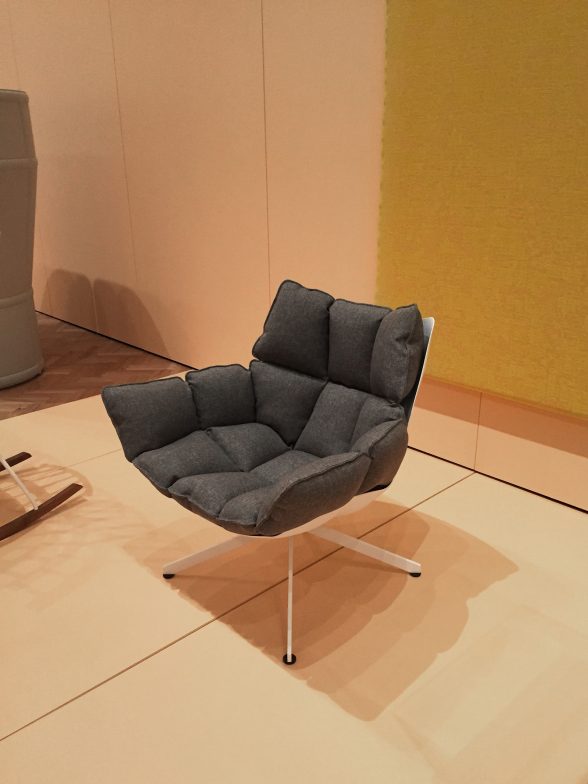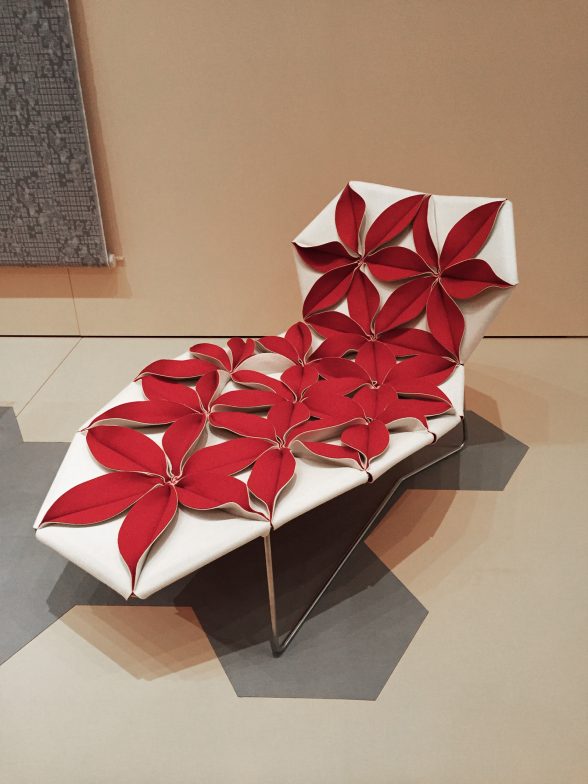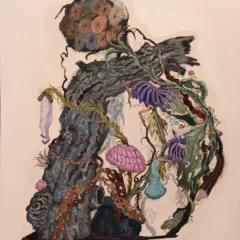Renowned designer Patricia Urquiola’s current exhibit at the Philadelphia Museum of Art, Between Craft and Industry, showcases her most prominent furniture, housewares, and interior designs. Known for sensory work that focuses on the emotional connection between the user and object, she combines traditional handicraft techniques with nostalgic and often provocative forms.
After studying architectural design at Madrid Polytechnic, Urquiola worked under esteemed Italian designers Vico Magistretti and Achille Castiglioni at Milan Polytechnic to hone her skills in industrial design. She is most known for her furniture portfolio, exclusive to high-end furniture companies such as B&B Italia, Haworth, Moroso S.p.A., and Flos, and has received several accolades including the Spanish Government’s Gold Medal of Fine Arts, induction into the Interior Design Hall of Fame (by Cindy Allen and Interior Design Magazine), and recently the Pennsylvania Museum of Art’s Collab Design Excellence Award in 2017.
From concept to product
I pass into a room to the right of Van Gogh’s Sunflowers, where Patricia Urquiola’s most notable furniture and houseware collection is arranged in an IKEA-esque configuration against a salmon colored platform. The work is laid out in a production line along the length of the rectangular space. First is the process wall. Clustered conceptual sketches, photos, and quotes provide insight into Urquiola’s thought process, focusing on the translation of craft inspired by traditional artifacts and the exploration of new materials.
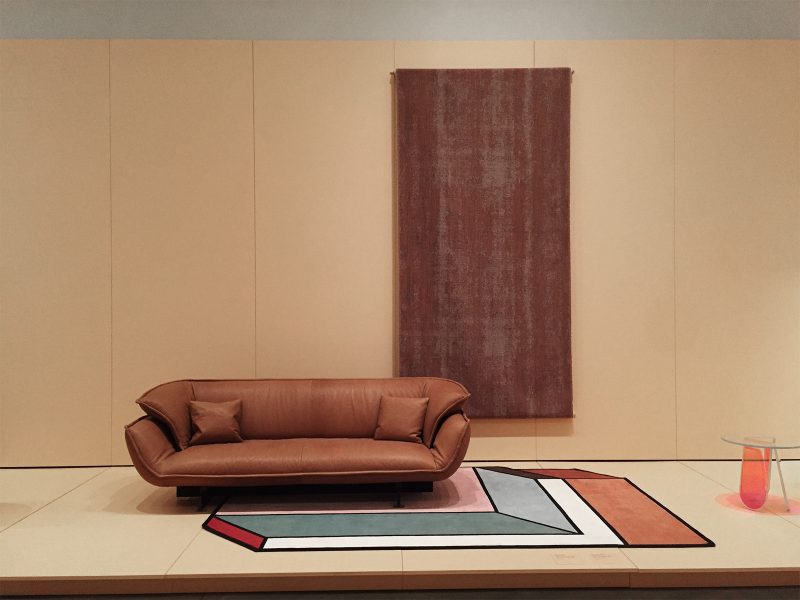
On some platforms, the pieces are curated to suggest domestic living arrangements — a chair and ottoman on a rug, illuminated by a lamp. On others they are positioned as sequential objects sitting in space. At the end of the exhibit are photos highlighting Urquiola’s interior design projects and featuring her industrial design pieces.
A group of school children briefly pass through the room to an adjacent exhibit, raving mixed reviews in their short intervention, “I love this room… it’s just a room of furniture…My mom is going to redo my room like this…” Meanwhile, a young couple ogles a looped rug, as if they are contemplating a home purchase at CB2.
Inspired by tradition
There is a certain utilitarian connotation to industrial design, especially furniture. We either like it or we don’t, usually based on a fundamental benchmark of comfort. Urquiola’s designs challenge conventional perception of how everyday objects, like chairs, lamps, or water pitchers, look, feel, and are used. More than meets the eye, her designs draw inspiration from familiar forms to induce emotion, and at times nostalgia. For instance, the “Chasen” Hanging Lamp abstracts the bamboo chasen whisk used to make matcha in traditional Japanese tea ceremonies. The fixture’s malleable metal loops are a literal translation of the whisk’s bamboo bristles. Similar to the traditional method of manually separating the bristles during fabrication, the spacing of the loops can be adjusted to create varying lighting levels.
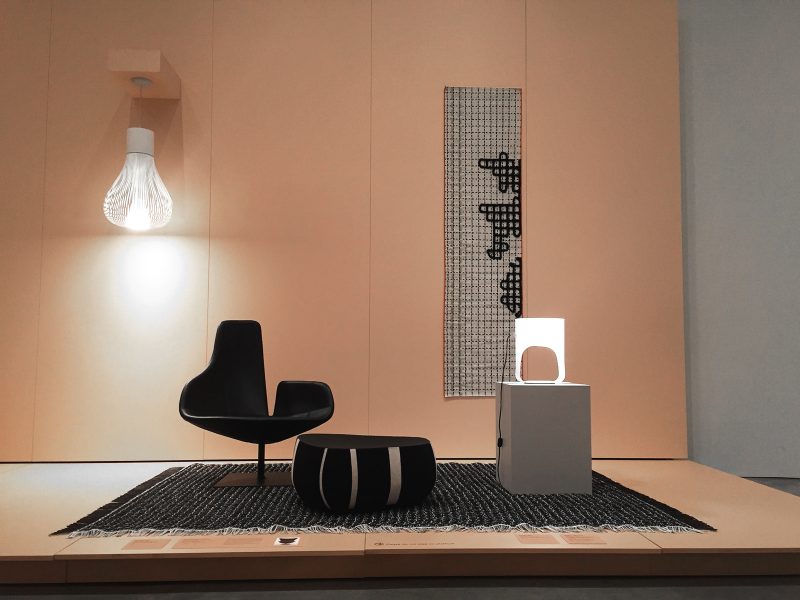
The first piece in the assembly of living arrangements is arguably the design that most clearly represents the modernization of traditional craft — the “Crinoline” Chair. As the name suggests, the chair’s aluminum-frame form is derived from the hooped petticoat used to puff out skirts in the 1800s. The structured yet organic chair mimics feminine curves and is embellished with floral patterns woven from polyethylene and abaca fibers obtained from the leafstalk of a banana native to the Philippines. Urquiola worked in collaboration with expert weavers in Asia to “give birth to” this delicate piece.
Look but don’t touch
I am intrigued by the simplicity of the “Husk” Armchair, a plushy grid of cotton cushions, reminiscent of those air pillow protective sheets you get in Amazon packages, molded to form a soft cusp within a rigid shell. Urquiola intended for these individual pillows to be disassembled and recycled for new use at the end of the chair’s lifecycle — an ethical consideration consistent in her work. The chair’s form has a captivating vacuum effect, tempting me to disobey the “Please Do Not Step on the Platform” sign to truly experience it.
Contrasting in texture is one of Urquiola’s best-known pieces, the “Antibodi” Chaise. From a distance, this chair appears painful to use, yet on closer inspection yields soft and delicate forms. Imagine a bed of sharp, red poinsettias made of malleable felt. This dimensional layer of the petals derives from the cellular patterning of antibodies. The felt is draped over a minimal stainless-steel frame, creating a hammock effect. I am conflicted about whether sitting here would evoke a sensation of lying in a lush meadow or prickly pile of autumn leaves.
The level of detail and craft in Urquiola’s work is impressive, however, the utilitarian aspect of her projects is meant to be experienced — not just seen. The opening line of the exhibit emphasizes “the physical and emotional interaction between the person and the object or interior being of paramount importance to her” and although the exhibit visually stimulates and challenges my perceptions of form and function, it leaves me longing to connect with her work on a tactile level. It’s like watching a movie with no sound. I am only able to imagine what straddling the “Genderless” Chair, or balancing my body weight over the delicate felt florals of the “Antibodi” Chaise, is like. Luckily, I can test these postulations out at the New York Moroso furniture showroom.
Between Craft and Industry is Urquiola’s first solo exhibit in the US, exclusive to the Philadelphia Museum of Art, and will be on view until March 18th, 2018.


